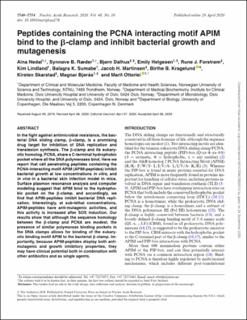| dc.contributor.author | Nedal, Aina | |
| dc.contributor.author | Ræder, Synnøve Brandt | |
| dc.contributor.author | Dalhus, Bjørn | |
| dc.contributor.author | Helgesen, Emily | |
| dc.contributor.author | Forstrøm, Rune Johansen | |
| dc.contributor.author | Lindland, Kim | |
| dc.contributor.author | Sumabe, Balagra Kasim | |
| dc.contributor.author | Martinsen, Jacob H. | |
| dc.contributor.author | Kragelund, Birthe B. | |
| dc.contributor.author | Skarstad, Kirsten Jane | |
| dc.contributor.author | Bjørås, Magnar | |
| dc.contributor.author | Otterlei, Marit | |
| dc.date.accessioned | 2020-09-25T11:12:45Z | |
| dc.date.available | 2020-09-25T11:12:45Z | |
| dc.date.created | 2020-05-07T16:06:31Z | |
| dc.date.issued | 2020 | |
| dc.identifier.citation | Nucleic Acids Research. 2020, 48 (10), 5540-5554. | en_US |
| dc.identifier.issn | 0305-1048 | |
| dc.identifier.uri | https://hdl.handle.net/11250/2679696 | |
| dc.description.abstract | In the fight against antimicrobial resistance, the bacterial DNA sliding clamp, β-clamp, is a promising drug target for inhibition of DNA replication and translesion synthesis. The β-clamp and its eukaryotic homolog, PCNA, share a C-terminal hydrophobic pocket where all the DNA polymerases bind. Here we report that cell penetrating peptides containing the PCNA-interacting motif APIM (APIM-peptides) inhibit bacterial growth at low concentrations in vitro, and in vivo in a bacterial skin infection model in mice. Surface plasmon resonance analysis and computer modeling suggest that APIM bind to the hydrophobic pocket on the β-clamp, and accordingly, we find that APIM-peptides inhibit bacterial DNA replication. Interestingly, at sub-lethal concentrations, APIM-peptides have anti-mutagenic activities, and this activity is increased after SOS induction. Our results show that although the sequence homology between the β-clamp and PCNA are modest, the presence of similar polymerase binding pockets in the DNA clamps allows for binding of the eukaryotic binding motif APIM to the bacterial β-clamp. Importantly, because APIM-peptides display both anti-mutagenic and growth inhibitory properties, they may have clinical potential both in combination with other antibiotics and as single agents. | en_US |
| dc.language.iso | eng | en_US |
| dc.publisher | Oxford University Press | en_US |
| dc.rights | Navngivelse 4.0 Internasjonal | * |
| dc.rights.uri | http://creativecommons.org/licenses/by/4.0/deed.no | * |
| dc.title | Peptides containing the PCNA interacting motif APIM bind to the beta-clamp and inhibit bacterial growth and mutagenesis | en_US |
| dc.type | Journal article | en_US |
| dc.type | Peer reviewed | en_US |
| dc.description.version | publishedVersion | en_US |
| dc.source.pagenumber | 5540-5554 | en_US |
| dc.source.volume | 48 | en_US |
| dc.source.journal | Nucleic Acids Research | en_US |
| dc.source.issue | 10 | en_US |
| dc.identifier.doi | 10.1093/nar/gkaa278 | |
| dc.identifier.cristin | 1809851 | |
| dc.relation.project | Helse Sør-Øst RHF: 2015095 | en_US |
| dc.relation.project | Helse Sør-Øst RHF: 2014034 | en_US |
| dc.relation.project | Norges forskningsråd: 2262/18 | en_US |
| dc.description.localcode | C The Author(s) 2020. Published by Oxford University Press on behalf of Nucleic Acids Research. This is an Open Access article distributed under the terms of the Creative Commons Attribution License (http://creativecommons.org/licenses/by/4.0/), which permits unrestricted reuse, distribution, and reproduction in any medium, provided the original work is properly cited. | en_US |
| cristin.ispublished | true | |
| cristin.fulltext | original | |
| cristin.qualitycode | 2 | |

